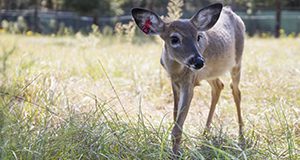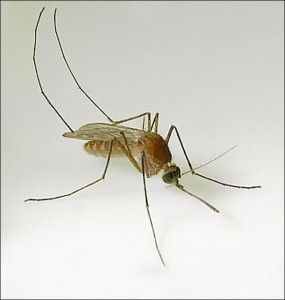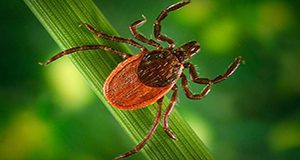Ehrlichiosis is a bacterial disease that is transmitted to humans and animals from ticks. In most cases, symptoms are mild, but sometimes if antibiotic treatment is delayed, it can cause severe illness and even death. In Florida, ehrlichiosis is an emerging disease. The hotspot of transmission is in north central Florida, but the disease is underdiagnosed. This 4-page fact sheet written by Yasmin Tavares and Samantha Wisely and published by the UF/IFAS Department of Wildlife Ecology and Conservation describes ehrlichiosis and explains how it is transmitted, how to know if you have it, and how to prevent yourself and your friends and family from getting it.
https://edis.ifas.ufl.edu/uw481
Tag: Samantha Wisely
White-tailed Deer of Florida

The white-tailed deer (Odocoileus virginianus) is the most economically important big game mammal in North America and Florida. This 12-page fact sheet written by Raoul K. Boughton, Bethany Wight, Samantha Wisely, Karen Hood, and Martin B. Main and published by the UF/IFAS Department of Wildlife Ecology and Conservation provides an overview of the various subspecies of white-tailed deer with populations in Florida and describes their history, biology, and management.
https://edis.ifas.ufl.edu/uw121
Facts About Wildlife Diseases: Eastern Equine Encephalitis

The Eastern equine encephalitis virus (EEEV) causes Eastern equine encephalitis (EEE) disease in birds, humans, horses, and other animals in the eastern United States, including Florida, which is especially receptive to the virus because of its freshwater hardwood swamps and wetlands, which provide good niches for the mosquito vectors of the disease. This 5-page fact sheet written by Samantha Wisely and Karen Hood and published by the UF/IFAS Department of Wildlife Ecology and Conservation describes the disease and includes strategies for limiting its spread.
http://edis.ifas.ufl.edu/uw453
Status of Capybaras (Hydrochoerus hydrochaeris Rodentia: Hydrochaeridae) and Potential for Establishment in Florida
Would you know what to do if you saw a two-foot-tall, 100-pound exotic rodent strolling through your neighborhood? It’s highly unlikely, but, depending on your location, not absolutely impossible. Capybaras, the world’s largest rodents, are native to South America but have been spotted in the state of Florida and may have potential to establish populations here. This 5-page fact sheet written by Brandon Parker, C. Jane Anderson, Christina Romagosa, Samantha Wisely, Daniel Pearson, John Seyjagat, and Katherine Ashley Sayler and published by the UF/IFAS Department of Wildlife Ecology and Conservation describes capybaras, explains how they got to Florida, and shows where the semiaquatic, herbivorous rodents have been sighted so far.
edis.ifas.ufl.edu/uw438
Facts about Wildlife Diseases: South Tick Associated Rash Illness or "STARI"
Southern tick-associated rash illness (STARI) is a human tick-borne disease that occurs following the bite of Amblyomma americanum, the lone star tick, which is the most common and aggressive human-biting tick in the South, accounting for over 90% of human tick bites in the region. STARI is often described as a “Lyme-like illness” because it causes a rash like the “bulls eye” rash associated with Lyme. Other symptoms of STARI that are similar to symptoms of Lyme disease include headache, fatigue, and muscle and joint pain. Scientists know the tick vector and that some wildlife species play a role in maintaining the disease in nature, but very little else is understood about this mysterious illness. This 4-page fact sheet written by Katherine Sayler, Carisa Boyce, and Samantha Wisely and published by the Department of Wildlife Ecology and Conservation provides the basic facts we do know, the differences between STARI and Lyme disease, plus advice for tick-bite sufferers and strategies to avoid tick bites.
http://edis.ifas.ufl.edu/uw421
Facts about Wildlife Diseases: Rabies
 Rabies is a virus carried by mammals. It kills infected humans and animals if they are not treated shortly after exposure. Rabies can be prevented, but it cannot be cured once symptoms become evident. This 6-page fact sheet explains how rabies spreads, which animals can get it, how common it is, symptoms, what you can do to limit its spread and what to do in case of a possible rabies exposure. Written by Samantha M. Wisely and Holly K. Ober, and published by the UF Department of Wildlife Ecology and Conservation, June 2015.
Rabies is a virus carried by mammals. It kills infected humans and animals if they are not treated shortly after exposure. Rabies can be prevented, but it cannot be cured once symptoms become evident. This 6-page fact sheet explains how rabies spreads, which animals can get it, how common it is, symptoms, what you can do to limit its spread and what to do in case of a possible rabies exposure. Written by Samantha M. Wisely and Holly K. Ober, and published by the UF Department of Wildlife Ecology and Conservation, June 2015.
http://edis.ifas.ufl.edu/uw282
Facts about Wildlife Diseases: Pseudorabies
 Pseudorabies primarily affects swine, but cattle, sheep and other mammals are susceptible to infection. Humans are not at risk. The superficial symptoms of this viral disease resemble rabies symptoms, thus the name pseudorabies. Although eliminated in commercial animals, feral swine populations in the United States continue to circulate the disease and provide a reservoir for outbreaks. Texas, Oklahoma, Florida, and Hawaii all have dense populations of feral swine with a high prevalence of pseudorabies. Feral swine, therefore, pose a serious risk to commercial swine operations, livestock, companion animals, and wildlife. This 4-page fact sheet was written by Samantha Wisely, and published by the UF Department of Wildlife Ecology and Conservation, August 2014.
Pseudorabies primarily affects swine, but cattle, sheep and other mammals are susceptible to infection. Humans are not at risk. The superficial symptoms of this viral disease resemble rabies symptoms, thus the name pseudorabies. Although eliminated in commercial animals, feral swine populations in the United States continue to circulate the disease and provide a reservoir for outbreaks. Texas, Oklahoma, Florida, and Hawaii all have dense populations of feral swine with a high prevalence of pseudorabies. Feral swine, therefore, pose a serious risk to commercial swine operations, livestock, companion animals, and wildlife. This 4-page fact sheet was written by Samantha Wisely, and published by the UF Department of Wildlife Ecology and Conservation, August 2014.
http://edis.ifas.ufl.edu/uw388


